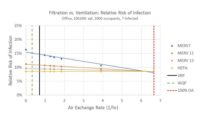From echoing hallways and idling buses to boisterous band practices and shop classes, schools have long been known as noisy environments. Beyond the sounds produced by occupants and vehicles, mechanical systems also add to the overall noise level on campus. HVAC systems serve as a good example of how mechanical components can contribute to clamor in the learning environment. The sound emitted when the air handling unit (AHU) starts up can create a distraction for students trying to focus or make it hard for them to hear the teacher.
The noise generated when sheet metal expands or contracts in response to pressure changes and the temperature of air flowing through the system can be easily carried throughout a building via ductwork. One effective strategy for addressing noise generated by the AHU is to insulate the ductwork. Uninsulated air ducts connecting rooms may allow for sound to easily transfer between spaces, posing problems for occupant learning, focus, and privacy.
Although insulation is well-known for its thermal properties, it can also support passive fire protection, provide moisture management, and improve acoustics. As this article focuses on noise mitigation, we’ll consider how insulating ductwork can help mitigate noise in schools and other buildings.
There are many insulating materials commercially available that can reduce sound transmission via ductwork. Fibrous insulating materials, such as fiberglass and elastomeric rubber foam both have advantages and disadvantages. As such, it’s helpful to have a standard for measuring a material’s ability to mitigate sound. It’s also helpful to understand the different tests used to evaluate these materials.
Testing ASTM C423
Manufacturers often rely on sound absorption data to convey the acoustic performance of their insulating products. Sound absorption provides a comparison between products as to which one has a higher probability of reducing the sound level within the duct. Sound absorption testing is typically conducted in a large reverberation chamber per ASTM C423: Standard Test Method for Sound Absorption and Sound Absorption Coefficients by the Reverberation Room Method or ISO 354: Acoustics – Measurement of Sound Absorption in a Reverberation Room. These tests are generally conducted utilizing pink noise between the frequencies 80 and 5000 Hz to excite the reverberation chamber long enough to reach a steady state in a diffuse sound field. The signal is then deactivated and the sound pressure level decay rate in each one-third octave, or octave band, frequency is determined by measuring the slope of the average decay curve for the sound pressure level.

Unfortunately, this method is only useful for estimating attenuation at low frequencies where the acoustical waves behave as plane waves. Measuring the actual performance of the duct liner products offers a more practical approach for comparing the effectiveness of different duct lining materials. We see in Table 1 that the ASTM C423 sound absorption test method suggests that fiberglass and foam materials perform similarly in the lower frequency range where structural and mechanical noise reside. Foam shows better performance in at least one frequency band.
Figure 2a plots the absorption coefficients in Table 1 using a 1-inch-thickness for each material. At frequencies below 250 Hz, the materials have similar performance. K-Flex (elastomeric) has better performance at 500 Hz. Both elastomeric foam products have lower performance across the other frequencies.

Figure 2b plots the average absorption coefficients from Table 1 for each material at a 1.5-inch thickness. (Note: K-Flex elastomeric did not show data for 1.5-inch thickness.) Again, foam and fiberglass material performances are similar at frequencies below 1000 Hz. However, for frequencies at 1000 Hz and greater, the fiberglass duct liner demonstrates higher performance.

Looking at Figure 2c, we see the average absorption coefficients for each insulating material at a 2-inch thickness. Once again, the performances of fiberglass and foam materials are similar, with the exception of 250 Hz. However, the fiberglass duct liner shows superior performance beginning at 500 Hz and above.

Whereas sound absorption testing provides a measure of a material’s ability to absorb sound, or noise, the noise reduction coefficient (NRC) is an average rating of how much sound an acoustic product can absorb. The NRC can be used to estimate the reduction in fan sound levels in ducted airflow systems.
Figure 3 compares the NRC for three thicknesses of each duct insulating material. The fiberglass liner materials demonstrate a higher NRC value compared to the foam material. While the difference is less at 1-inch thickness, the performance of foam is still lower than that of the fiberglass materials.
Testing ASTM E477
Measuring the actual performance of different duct lining products offers a practical solution for comparing their effectiveness in mitigating sound within a duct. ASTM E477: Standard Test Method for Laboratory Measurements of Acoustical and Airflow Performance of Duct Liner Materials and Prefabricated Silencers provides for laboratory testing of the acoustical properties of sound attenuation in ducts, including duct liner materials. As opposed to the tests that measure the sound absorption coefficient or noise reduction coefficient of different materials, ASTM E477 tests for insertion loss, comparing the performance of ducts treated and untreated with different insulating materials.

Insertion loss refers to the reduction of noise level due to placement of a sound attenuating material or device in the sound path between the sound source and a given location. The test for insertion loss in building ductwork is completed by determining the difference in sound pressure level in a reverberation chamber from an untreated duct and a treated duct. The individual ducts are connected to a sound generation chamber on one end and a reverberation chamber on the other. Speakers in the sound generation chamber emit pink noise that propagates toward the reverberation chamber through the duct system. Insertion loss between the untreated and treated duct is measured both with and without air flowing through the duct.
To measure the insertion loss of fiberglass and foam duct liners, an acoustic study was performed by a third-party laboratory. The test was conducted per the ASTM E477 standard at one of the few select facilities around the world equipped to conduct the test. Two rectangular duct geometries were submitted: a 12-by-24-inch duct and a 24-by-24-inch duct, both constructed from 24-gage sheet metal, 0.0250-inch thick (0.64 mm). A 1-inch duct liner material was selected for the test. For a 1-inch duct liner, actual duct size for testing is 26-by-26-inch square and 14-by-26-inch rectangular to allow for the liner thickness.
After testing untreated duct supplied by the testing lab, duct liner specimens were mounted onto the test apparatus. Sound traveled from left to right in the pictures and into the reverberation chamber.
What does the data say?
The average insertion loss of the liners for both duct sizes was tested. Data indicates that the fiberglass duct liner provides better insertion loss compared to the foam duct liner. The foam duct liner demonstrated good performance in sound absorption per ASTM C423 at frequencies below 1000 Hz. However, that does not appear in the insertion loss data. For frequencies below 250 Hz, which is the HVAC mechanical system noise domain, in the 12-inch-by-24-inch duct, and frequencies below 160 Hz for the 24-inch by 24-inch duct, the fiberglass duct liner appears to be the only product with any insertion loss performance. The foam liner does not appear to have insertion loss greater than 0.3 dB/foot below 630 Hz for the 12-inch-by-24-inch duct tested.,
To reduce the sound level by the same amount below 800 Hz with the foam duct liner, as much as three times the length of duct would need to be treated compared to the fiberglass duct liner. These frequencies are important because much of the HVAC sound generated by Variable Air Volume (VAV) units, reciprocating and centrifugal compressors, fan instability, and turbulent flow is below 800 Hz.
Accurate testing is critical
The setup for testing per the ASTM E477 is capital intensive and requires significant space, including a reverberation room qualified to test per the requirements of ANSI Standard S12.51/ISO 3741: Acoustics – Determination of Sound Power Levels and Sound Energy Levels of Noise Sources Using Sound Pressure – Precision Methods for Reverberation Test Rooms. The limited availability of testing facilities could be one reason why some manufacturers opt to test their products using sound absorption, even though it doesn’t properly represent performance in the installed application.
ASHRAE developed tables showing insertion loss data based on laboratory tests using 10-foot lengths of duct in the 1980s. Chapter 49.22 of the ASHRAE Handbook (2019) includes Tables 17-18 for selected rectangular sheet metal ducts, showing the insertion loss values (dB/foot) for 1- and 2-inch fiberglass duct lining. While these tables can provide guidance and eliminate the cost of testing, products evolve, and this data may not accurately represent more recently developed insulating products.
Matching the insulation to the install
As the installed environment is the ultimate laboratory for evaluating a product’s performance, standards such as sound absorption data may not accurately reflect performance in use. Considering the sound absorption data presented earlier, it could be inferred that, at lower frequencies, the foam and fiberglass insulating materials deliver comparable performance. However, looking at results from testing per the ASTM E477 standard, we see that fiberglass provided three to four times the insertion loss of the foam. Considering the improved efficacy of fiberglass liner in reducing sound traveling through ducts and the significantly smaller amounts of fiberglass material needed to meet noise reduction goals compared to foam, fiberglass offers a preferred path for mitigating noise traveling through ductwork. Additionally, the study demonstrates that ASTM E477 provides a more robust standard for evaluating insulation for ducts in schools and other commercial buildings where thermal and acoustic performance in ducts is desired.




